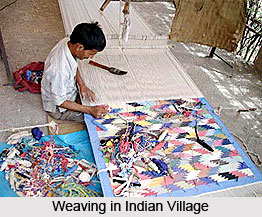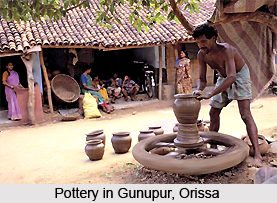 Art in India does not require a canvas to portray itself and the Indian village art reflects this very notion. Amongst a host of art and crafts, paintings in Indian villages enchant the beholders with their hues and themes. Paintings in India villages does not require a set canvas; these can be spotted on walls of the havelis, pots, sarees, baskets, glass and several other objects. India was always a rendezvous for painters of different cultures and nations. In fact a number of painting schools evolved in India; whilst some borrowed their themes from religion, like the Warli Paintings, others concentrated more on landscapes, dances, love scenes and village scenes.
Art in India does not require a canvas to portray itself and the Indian village art reflects this very notion. Amongst a host of art and crafts, paintings in Indian villages enchant the beholders with their hues and themes. Paintings in India villages does not require a set canvas; these can be spotted on walls of the havelis, pots, sarees, baskets, glass and several other objects. India was always a rendezvous for painters of different cultures and nations. In fact a number of painting schools evolved in India; whilst some borrowed their themes from religion, like the Warli Paintings, others concentrated more on landscapes, dances, love scenes and village scenes.
In ancient India painters hailed from rural India and were hired by jagirdars or landlords to beautify their walls and ceilings. This is evident from the havelis that re still to be found in Rajasthan and the ancient houses in Haryana. One of the popular motifs of the paintings in Indian villages was the image of Lord Krishna. Mural paintings are widely found in the houses of Rajasthan even today. Besides these religious themes, birds, wrestling bouts, floral motifs, hunting excursions, etc were also depicted by the village artisans.
 India is often depicted as the land of villages and it is in such villages that artistry has thrived for ages. At the beginning of the16th century Indian painters were primarily engaged in religious art. They painted religious figures and exemplified these paintings wit frescos and ornate designs. With the coming of the Mughals painting took the shape of a court art. Artists from Indian villages were commissioned to illustrate figures or episodes from Persian texts. Whether it were the paintings in the villages of north India or south India, religion appeared to be a significant theme in the paintings in Indian villages.
India is often depicted as the land of villages and it is in such villages that artistry has thrived for ages. At the beginning of the16th century Indian painters were primarily engaged in religious art. They painted religious figures and exemplified these paintings wit frescos and ornate designs. With the coming of the Mughals painting took the shape of a court art. Artists from Indian villages were commissioned to illustrate figures or episodes from Persian texts. Whether it were the paintings in the villages of north India or south India, religion appeared to be a significant theme in the paintings in Indian villages.
Paintings in Indian villages also comprise the tribal and folk arts. Being a multicultural land, painters from varied communities have contributed time and again to enrich Indian art scenario. Originating in Orissa this type of folk painting is equally famous in West Bengal. Another form of painting that was mainly done by village women from Bihar is Madhubani Painting. Famous for its religious motifs, this form of village paintings are still done in Mithila. The history of Tanjore paintings also dates back to ancient era. This type of painting originated in Tamil Nadu and draws its themes from religion as well. As far as folk paintings are concerned Gujarat, Rajasthan, Orissa, West Bengal, Bihar, Andhra Pradesh, Tamil Nadu, etc are famous. Paintings in northeast Indian villages flourished primarily as monastery art. Later these motifs were used as ornamental designs on various forms of crafts as well. One of the most popular forms of paintings in the villages nestled at the feet of Himalayas is Thangka. Though this form of originated in Tibet it travelled to India with the spread of Buddhism. Arunachal Pradesh, Sikkim and others are well known for their artistry. Tribal paintings are also part of the village artistry in these regions.
Besides these glass and miniature paintings of rural India are also esteemed by connoisseurs of art. India is also home to a number of tribes; hence their art and culture also had an impact on Indian ethos. Pithora paintings of Rathwa tribe, Saora paintings, Gond paintings and Khovar and Sohrai tribal art from Jharkhand are also part of the paintings in Indian villages. Tribal paintings portray themes like nature and day to day village life. These paintings, however, differ from region to region in India. Villages of Orissa, Jharkhand, Madhya Pradesh, Gujarat, Maharashtra, etc are famous for their tribal paintings.
For centuries unknown artists have consistently contributed to enrich Indian paintings. Whilst in contemporary India art has travelled far and wide, its origin is buried in the rural India. Since times immemorial painters from villages have given their art form new dimensions. As a result paintings, and art as a whole, progressed with time. Cultural changes were accepted and amalgamated within the ingenuous forms. Hence, contemporary India is home to some of the most sought after pieces of paintings. Paintings in Indian villages are, even today, reckoned as one of the distinguished art forms.




















